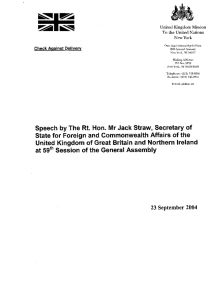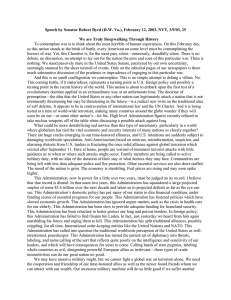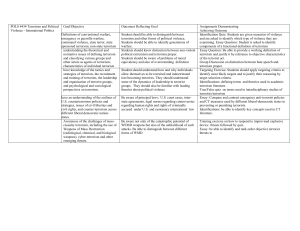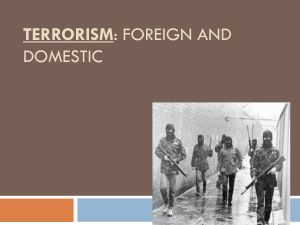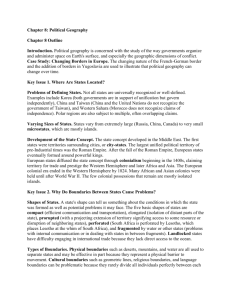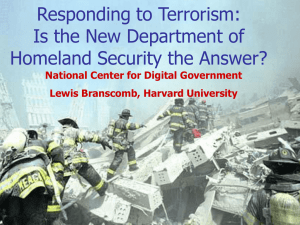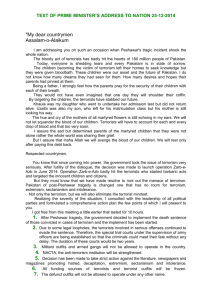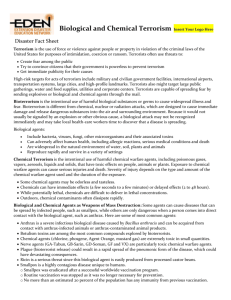Chapter 36 - St. Dominic High School
advertisement
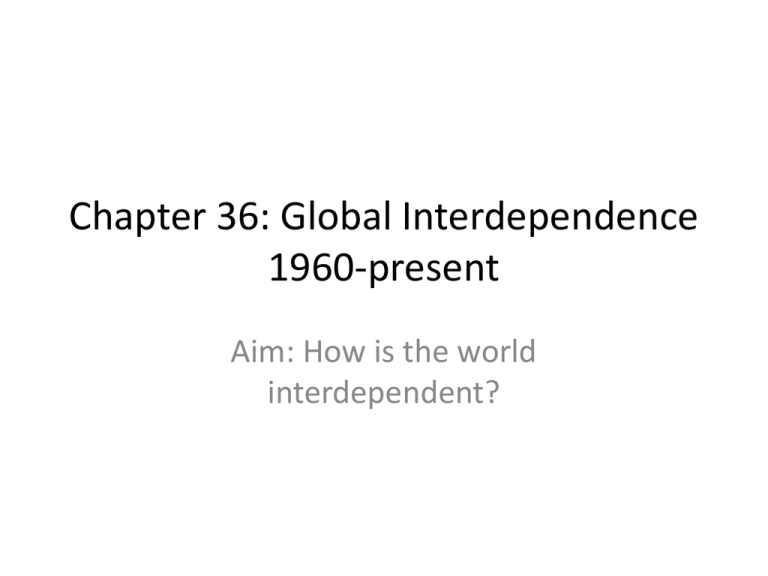
Chapter 36: Global Interdependence 1960-present Aim: How is the world interdependent? Section 1: The Impact of Technology • Through advances in science & technology, the countries of the world have become increasingly interdependent, resulting in new global challenges Do Now: • Underline key words in the statement above • Define interdependence The Impact of Science & Technology • Advances in technology after WWII lead to increased global interaction and improved quality of life • What ways has technology changed since the 1960’s? • How does this improve our quality of life and global interaction? Exploring the Solar System & Beyond Cooperation in Space • In the early 1970s, Soviets and US start cooperating in space • Since 1980’s US space shuttles often have international crews • International Space Stationspace project involving 16 nations • Suspension of US shuttle program endangers station’s completion Exploring the Universe • Unmanned probes are sent to study the outskirts of the solar system • US & European space agencies put Hubble Space Telescope into orbit Expanding Global Communications Smaller & More Powerful Computers • Computer components miniaturized due partly to the space program • Computers can fit in hands, instead of needing a whole room • Computer became common place in factories, offices, vehicles, homes Communications Network • Internet- linkage of computer networks spanning the world • Internet use soars from 26 to 600 million people from 1995-2002 • Internet greatly affects business & speeding up flow of information Transforming Human Life Health & Medicine The Green Revolution • New technologies make it easier to diagnose problems and do surgery • Genetics- study of heredity through gene researchexpands in 1980s • Genetic engineering- changing organism’s genes to affect its traits • Cloning- copying genes to reproduce an identical organism • Green Revolution- an attempt to increase food production worldwide • Increased use of fertilizers, pesticides and improve crop strains • Green revolution increases yields & puts some farmers out of business • Genetic engineering used to breed helpful traits into crop strains Section 2: Global Economic Development The economies of the world’s nations are so tightly linked that the actions of one nation affect others. Technology Revolutionizes the World’s Economy Advances in Industry • Progress in science leads to new industries • Technological advances change industrial processes • Production costs are lower • Quality and speed of production increases Information Industries Change Economies • New technologies reduce need for factory workers • Using computers, information industries enjoy great growth The Effects of New Economies • Post-war boom benefits many nations; cause shifts in economic bases • Developed nations- nations with advanced business infrastructure • Emerging nations- nations in the process of becoming industrialized • Manufacturing moves to emerging nations with cheap, eager labor • Information industries multiply in developed nations Economic Globalization Global Economy • Global economy begins to take shape in second half of 1800s • Global economy- financial interactions across international borders Multinational Corporations • Many European, Japanese, and US companies spread across the world • Establish offices, manufacturing or stores in many countries Expanding Free Trade • Free trade- elimination of tariffs, trade barriers between nations • Since 1995, World Trade Organization oversees free trade expansion Economic Globalization Regional Trade Blocs • Starting in 1950s, European Economic Community becomes a major force • In 1992, takes name European Union (EU) and includes much of Europe • US, Mexico & Canada form NAFTA in 1994 • North American Free Trade Agreement eliminates trade restrictions Globalization- For and Against • Supporters note that globalization increases standard of living • Opponents say developed nations benefit most and poor nations stay poor Impact of Global Development Political Impacts Environmental Impacts • Energy shortages can restrict trade, causing political problems • Since the 1950s, oil has been major source of energy worldwide • 1970s oil embargo causes economic problems for developed nations • In 1990, Iraq invades Kuwait, seizes vast oil fields • Fears mount that Iraq might control majority of world’s petroleum • In early 1991, many nations send armies, drive Iraq out of Kuwait • Burning oil and coal promote development but damage environment • Ozone layer- atmospheric layer that filters out uv (ultraviolet) light • Chemicals called CFCs (chlorofluorocarbons) damage ozone layer, skin caner increase • More farming damages land; habitat destruction endangers wildlife “Sustainable Growth” • Scientists want to reduce the harm development does to environment • Sustainable growth- preserving environment meeting economic needs Section 3: Global Security Issues Since 1945, nations have used collective security efforts to solve problems Issues of War & Peace Nations unite and take action • After WWII, many nations join together in military alliances • World leaders create the UN (United Nations) to avoid war when possible Peacekeeping activities • UN mediates disputes between nations, provides peacekeeping forces • In 2007, UN has 82,000 peacekeepers around the world Issues of War & Peace Weapons of Mass Destruction • Nations sign treaties against chemical, biological and nuclear weapons • Proliferation- spreading of nuclear weapons Disarming Iraq • Iraq expels inspectors overseeing destruction of banned weapons • UN threatens “severe consequences” if Iraq stops inspectors’ return • In 2003, US and Britain lead coalition to disarm Iraq by force • Captured in 2003, tried & executed in 2006 Human Rights Issues The UN and Human Rights • Universal Declaration of Human Rights- sets human rights standards • UN and other organizations work to improve human rights worldwide Continuing Rights Violations • Some governments suppress political dissentdifference of opinion • Rwandan genocide, mass murder of about 500,000 Tutsis by Hutus • In Darfur, accusations of genocide; hundreds of thousands of refugees and the deaths of 200,000 Human Rights Issues Women’s Status Improves • Women gain rights like holding political office or better educations • Gender inequality- status differences between man and women- remains Health Issues World Health • Standard of health increased in recent years but damages remain • Severe acute respiratory syndrome (SARS) a major problem in 2003 The AIDS Epidemic • AIDS- acquired immune deficiency syndrome, first discovered in 1980s • AIDS attacks the immune system, weakening the body’s defenses • Millions worldwide infected with HIV, the virus that cause AIDS • Sub-Sahara Africa has by far the most AIDS cases and deaths Population Movement Push-Pull Factors • Many factors, like food shortage, push people to leave their homes • Refugees- people who leave their country to find safety in another • Many people pulled to developed nations hoping for a better life Effects of Migration • Some countries do not want refugees, turn them away • Many refugees live in camps and have nowhere to go • Immigrants provide needed labor and enrich culture Section 4: Terrorism Terrorism threatens the safety of people all over the world What is Terrorism? Modern Terrorism • Terrorism- use of violence to force social or political change • More than 14,000 terrorist attacks worldwide since 1960 • Many terrorists have political goals; some have religious motives Terrorist Methods • Terrorists use bombs, guns, sometimes chemical, biological agents • Terrorists gain attention by striking high-profile, symbolic targets • Cyber terrorism- attacks on computer and information systems Responding to Terrorism • Governments try to stop terrorists groups and cut off their funding International Terrorism Gets Attention • Palestinian terrorists kill Israeli athletes at 1972 Munich Olympics Terrorism Around the World The Middle East • Many terrorist groups founded because of IsraeliPalestinian conflict • These groups want Palestinian homeland • Pattern: terror strikes, Israeli retaliation, more terror attacks Europe • IRA- Irish Republican Army opposes British control of Northern Ireland • Negotiations for a peaceful resolution ongoing since 1998 Terrorism Around the World Asia • In 1996, al-Qaeda and Osama bin Laden set up base in Afghanistan • Japanese religious cult launches gas attack in Tokyo subway in 1995 Africa • Regional wars and civil unrest lead to terrorism in Africa • Al-Qaeda linked to attacks on US personnel and facilities there Latin America • Terrorism linked to drug trafficking; nacroterrorism a major problem • Colombia fights guerrilla groups linked to drug traffickers Case Study: Sept. 11, 2001 Attack on US • On Sept. 11, 2001, Arab terrorists hijack 4 airliners • Hijackers crash two jets into World Trade Center towers in NY • A third jet crashes into the Pentagon • The 4th crashes into a field in Pennsylvania The Destruction • WTC towers collapse; extensive damage at Pentagon • 3,000 die in attacks • Victims include about 400 NY city firefighters and police The Impact of the Attack • Many Americans feel vulnerable as a result • Members of Congress & media workers get anthrax-tainted letters (biological threat) • 5 people, including 2 postal workers killed by anthrax • No link found between anthrax & Sept.11th; both spread fear The US Responds Antiterrorism Measures • Department of Homeland Security- created in 2002 to fight terrorism • US detains Arabs; Muslims considered suspicious; many protest • Government defends wartime suspension of civil liberties • In 2001, Congress passes USA Patriot Act- anti-terrorism measures Aviation Security • Sky Marshals, National Guard provide airplane & airport security • Airport inspections & cockpit security increase Section 5: Cultures Blend in a Global Age Technology has increased contact among the world’s people, changing their cultures Cultural Exchange Accelerates Popular Culture & Mass Media • Popular Culture- cultural elements reflecting a common background • Access to TV high in developed nations, increasing in emerging world • Newscasts and documentaries spread information quickly • TV, radio, movies & other mass media spread popular culture International Elements of Popular Culture • American programs are broadcast all over the world • Sports, music from around the world are broadcast to other countries World Culture Blends Many Influences Westernizing Influences on Different Cultures • European colonization and Western mass media spread western culture • English is the premier international language • growth of materialismplacing high value on material possessions Non-Western Influences • Non-Western ideas also come to Europe & the US • Music, clothing styles, ideas, religion entering Western life • Better transportation, technology spread art, literature worldwide Future Challenges & Hopes Reactions to Global Popular Culture • Many seek to limit West’s influence to preserve national identity • Others modify or censor incoming mass media • Some react by trying to preserve to traditional ways of life Global Interdependence • People around the world realize how events far away affect them • Economic, political, environmental issues bring nations together • Humans face new challenges as they increase contact


